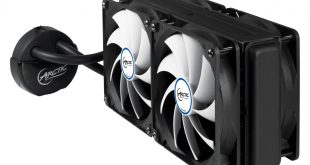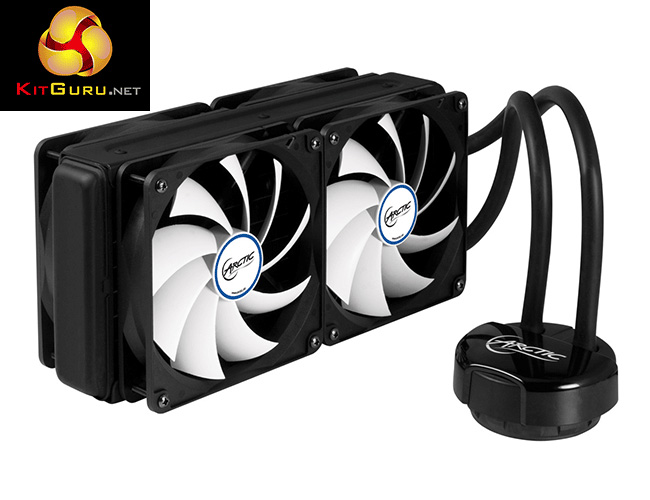
Typically, the better performing 240mm+ watercooling AIOs command a price premium. After all, in our 6 way round-up back in July, the coolers which claimed the top two spots both cost in excess of 100 pounds. However, Arctic are trying to change that with the Liquid Freezer 240, which costs just £75.95.
For that price, the Arctic Liquid Freezer 240 offers consumers four of Arctic's F12 fans, a 38mm-thick radiator and a clean, minimal design. For the money, it certainly seems like an enticing deal – but before jumping to any conclusions we must assess the performance of the unit. In this review we go over the installation process, raw cooling performance as well as noise output to see if the Liquid Freezer 240 is worthy of your money.
Specifications
- Supports Intel Socket: 1150, 1151, 1155, 1156, 2011*, 2011-3* (*SQUARE ILM (80 x 80 mm spacing) only)
- AMD Socket: AM2(+), AM3(+), FM1, FM2(+)
- Max. Cooling Performance: 350 Watts
- Recommended for TDP up to: 300 Watts
- Radiator width: 120mm
- Radiator length: 272mm
- Radiator depth: 38mm
-
Voltage: DC 5V – 12V
-
Power Consumption: 2.0 W
-
Cold Plate: Micro Skived Fin, Copper
-
Tube Length: 326 mm
-
Tube Diameter:
-
Outer 10.6 mm, inner 6.0 mm
-
Pump Dimensions (w/o tubes): 82 x 82 x 40mm (L x W x D)
-
Radiator Material: Aluminium
-
Fan: 120 mm x 4
-
Fan Speed: 500 – 1350 RPM (PWM)
-
Airflow: 74 CFM / 126 m³/h per fan
-
Voltage: DC 12 V
-
Current: 0.25 A (max)
-
Noise Level: 0.3 Sone
-
Connector: 4 Pins with PST
 KitGuru KitGuru.net – Tech News | Hardware News | Hardware Reviews | IOS | Mobile | Gaming | Graphics Cards
KitGuru KitGuru.net – Tech News | Hardware News | Hardware Reviews | IOS | Mobile | Gaming | Graphics Cards




How many watts does the test PC and/or CPU consume at 4.5 GHz under load?
Good question Rob. Next time I get a cooler in for review I will find out and get back to you. I don’t use a GPU, so I can’t imagine much more than 200W – maybe 250.
Wow this sounds great. I just hope I can get all 4 fans to fit into my case!
If it doesn’t fit in your case just put two fans outside and then the radiator and 2 fans inside the case
Also, be sure to have then sucking cooler air from outside rather than the other way around and then fit removable mesh filters to the intakes to cut down on dust being sucked in, this also creates positive pressure in the case so you don’t have to worry about dust being sucked in through every gap and vent hole the case has
If you want to take it a step further get some Perspex or plastic and create a wind tunnel to the rear exhaust fan at the back on most cases. This works like a PSU then taking cooler air from outside but not allowing it once its taken heat from the radiator into the main volume of the case itself as its instantly vented straight out of the back. Modern PSU/case combos do this too by the PSU sucking air through a (normally dust filtered) hole on the bottom and venting straight out of the back. You can even forgo the rear exhaust fan if you want as with 4 fans already sucking the air in I doubt a 5th one at the rear would do much and could be forced to spin faster than it wants by the airflow from the cooler anyway
If you do that however make sure to compensate for the main volume of the cases air flow though by using all other available fan locations as intakes
With a bit of imagination and not that much extra work you can get some excellent results and temps. I’ve been doing it this way for well over 2 decades on desktops and servers, and have even done similar with air coolers using a duct from one intake fan to the intake (push) on an air cooler then another duct from the exhaust (pull) fan on the cooler to an exhaust fan on the case. This makes even the relatively cheap evo 212 work amazingly well especially if you swap out the fans for something like corsair or arctic fans (2z92mm on the cooler and 2×120/140mm as the case intake and exhaust)
I really don’t find a 15 minutes stress test enough for an AIO cooler. Water temperatures don’t equalize in such short time. You should leave it at least 45 minutes under stress to get an accurate measurement. I consider these results invalid.